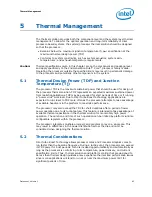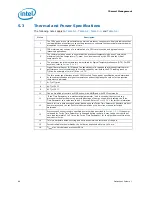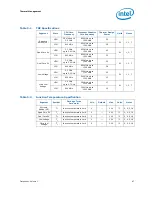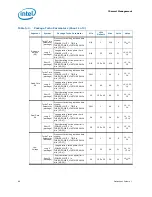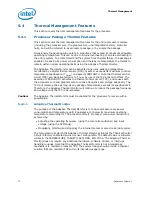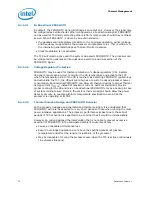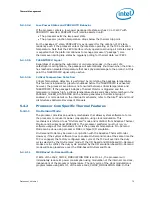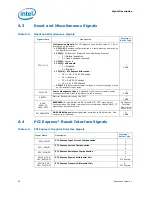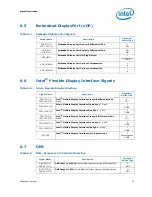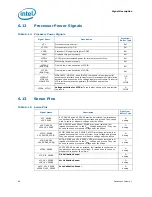
Datasheet, Volume 1
75
Thermal Management
5.4.1.3.4
Low-Power States and PROCHOT# Behavior
If the processor enters a low-power package idle state such as C3 or C6/C7 with
PROCHOT# asserted, PROCHOT# will remain asserted until:
• The processor exits the low-power state
• The processor junction temperature drops below the thermal trip point.
For the package C7 state, PROCHOT# may de-assert for the duration of C7 state
residency even if the processor enters the idle state operating at the TCC activation
temperature. Note that the PECI interface is fully operational during all C-states and it
is expected that the platform continues to manage processor (“package”) core
thermals even during idle states by regularly polling for thermal data over PECI.
5.4.1.3.5
THERMTRIP# Signal
Regardless of enabling the automatic or on-demand modes, in the event of a
catastrophic cooling failure, the package will automatically shut down when the silicon
has reached an elevated temperature that risks physical damage to the product. At this
point the THERMTRIP# signal will go active.
5.4.1.3.6
Critical Temperature Detection
Critical Temperature detection is performed by monitoring the package temperature.
This feature is intended for graceful shutdown before the THERMTRIP# is activated;
however, the processor execution is not ensured between critical temperature and
THERMTRIP#. If the package's Adaptive Thermal Monitor is triggered and the
temperature remains high, a critical temperature status and sticky bit are latched in the
PACKAGE_THERM_STATUS MSR 1B1h and also generates a thermal interrupt if
enabled. For more details on the interrupt mechanism, refer to the
Intel
®
64 and IA-32
Architectures Software Developer's Manuals.
5.4.2
Processor Core Specific Thermal Features
5.4.2.1
On-Demand Mode
The processor provides an auxiliary mechanism that allows system software to force
the processor to reduce its power consumption using clock modulation. This
mechanism is referred to as “On-Demand” mode and is distinct from Adaptive Thermal
Monitor and bi-directional PROCHOT#. The processor platforms must not rely on
software usage of this mechanism to limit the processor temperature. On-Demand
Mode can be done using processor MSR or chipset I/O emulation.
On-Demand Mode may be used in conjunction with the Adaptive Thermal Monitor.
However, if the system software tries to enable On-Demand mode at the same time the
TCC is engaged, the factory configured duty cycle of the TCC will override the duty
cycle selected by the On-Demand mode. If the I/O based and MSR-based On-Demand
modes are in conflict, the duty cycle selected by the I/O emulation-based On-Demand
mode will take precedence over the MSR-based On-Demand Mode.
5.4.2.1.1
MSR Based On-Demand Mode
If Bit 4 of the IA32_CLOCK_MODULATION MSR is set to a 1, the processor will
immediately reduce its power consumption using modulation of the internal core clock,
independent of the processor temperature. The duty cycle of the clock modulation is
programmable using Bits 3:1 of the same IA32_CLOCK_MODULATION MSR. In this



